|
HALLOWEEN
SPECIAL
Monster Collectibles
Are Still a
Graveyard Smash
by Bob Brooke
I was working in the lab, late one night
When my eyes beheld an eerie sight
For my monster from his slab, began to rise
And suddenly to my surprise
He did the mash, he did the monster mash
The monster mash, it was a graveyard smash
He did the mash, it caught on in a flash
He did the mash, he did the monster mash.
Lyrics from “Monster Mash” from Pickwick
International, 1974
Along with the usual array of ghosts and witches parading the streets on
Halloween, look closely and you're bound to see versions of monsters
from yesteryear—Frankenstein, The Wolfman, and Dracula. All are as much
a part of Halloween as pumpkins glowing on front porches. Even though
these films date from decades ago, the classic Universal Studios
monsters are still among the most recognized images to come from the
silver screen. While Universal designed those early film monsters to
simply scare moviegoers, the creatures moved into the toy and
collectibles world during the 1960s. Today, the demand for classic
monster collectibles has generated a thriving market with prices that
might frighten some beginning collectors as much as the monsters would
have scared their grandparents.
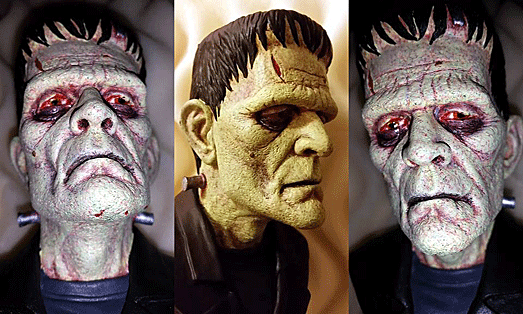
The History of Movie Monsters
The history of monster movies goes way back to the beginning of
commercial filmmaking. Thomas Edison produced the first film
adaptation of Mary Shelly's Frankenstein in 1910. The film
featured a man-made monster who terrorized a local village. Filmed
At his Black Maria studio, Film historians consider Edison's
kinetoscope release of "Frankenstein” to be the first American
horror film. Soon, filmmakers worldwide were adding their own
contributions to the genre.
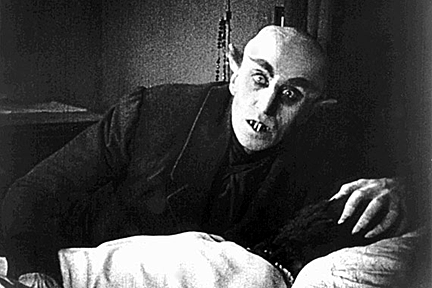 Some
of the best came from Germany. Similar to the story of Frankenstein
were three silent films produced by German film maker Paul Wegner in
1914, 1917, and 1920 based on the Jewish legend of The Golem, a clay
figure brought to life by a magical incantation, who would later
turn on his master. Another German, F.W. Murnau, directed an
unauthorized adaptation of Bram Stoker's vampire novel Dracula.
The film, entitled "Nosferatu: Symphony of Horrors," featured Max
Shreck as the haunting vampire, Graf. Florence Stoker, Bram Stoker's
widow sued and successfully won a copyright infringement lawsuit
against the makers of the film. The court ordered all copies of "Nosferatu"
destroyed. But like the Count himself; the film proved difficult to
get rid of. Copies of it escaped the celluloid holocaust and began
resurfacing years later. Some
of the best came from Germany. Similar to the story of Frankenstein
were three silent films produced by German film maker Paul Wegner in
1914, 1917, and 1920 based on the Jewish legend of The Golem, a clay
figure brought to life by a magical incantation, who would later
turn on his master. Another German, F.W. Murnau, directed an
unauthorized adaptation of Bram Stoker's vampire novel Dracula.
The film, entitled "Nosferatu: Symphony of Horrors," featured Max
Shreck as the haunting vampire, Graf. Florence Stoker, Bram Stoker's
widow sued and successfully won a copyright infringement lawsuit
against the makers of the film. The court ordered all copies of "Nosferatu"
destroyed. But like the Count himself; the film proved difficult to
get rid of. Copies of it escaped the celluloid holocaust and began
resurfacing years later.
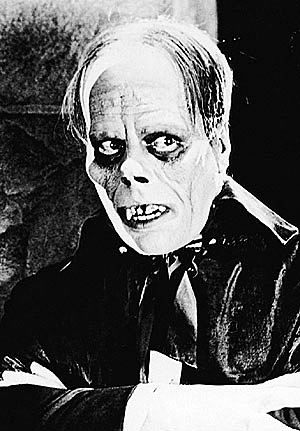 Universal
Studios produced some of the best of the genre in the 1920s,
including The Phantom of the Opera” and “The Hunchback of Notre
Dame,” both starring Lon Chaney Sr. Universal
Studios produced some of the best of the genre in the 1920s,
including The Phantom of the Opera” and “The Hunchback of Notre
Dame,” both starring Lon Chaney Sr.
But it was in 1931 when all horror hell broke loose for Universal.
One historic release was James Whale's frightening screen version of
"Frankenstein," portrayed by the then struggling actor Boris Karloff,
the haunting, supernatural appearance of the Monster terrified
unsuspecting audiences. Sewn together from the bodies of harvested
corpses with electrodes protruding from his neck, the Monster looked
like a hideous creation reanimated from the dead. Released in the
same year was Todd Browning's chilling adaptation of Brain Stoker's
Dracula. Originally intended for Lon Chaney Sr., the role eventually
went to Hungarian-born actor Bela Lugosi after Chaney's death in
1930. A stage version
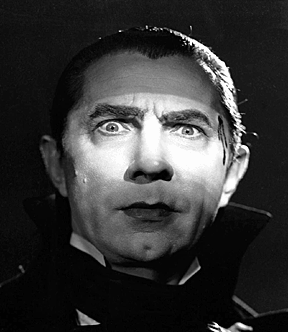 of
Dracula with Lugosi as the Count had preceded the film. Unlike
Frankenstein's Monster whose appearance could be changed for
horrific effect, the bloodthirsty Count had to appear human, but
scary. Lugosi's mysterious, sinister semblance combined with his
haunting European accent perfectly provided the Count with the
eeriness the role required. of
Dracula with Lugosi as the Count had preceded the film. Unlike
Frankenstein's Monster whose appearance could be changed for
horrific effect, the bloodthirsty Count had to appear human, but
scary. Lugosi's mysterious, sinister semblance combined with his
haunting European accent perfectly provided the Count with the
eeriness the role required.
Frankenstein was such a screen success that it spawned a long line
of wonderfully frightening sequels, featuring some of his relatives,
starting with The Bride of Frankenstein. Others that followed in the
1930s and 1940s included Son of Frankenstein, Frankenstein Meets the
Wolf Man, and House of Frankenstein.
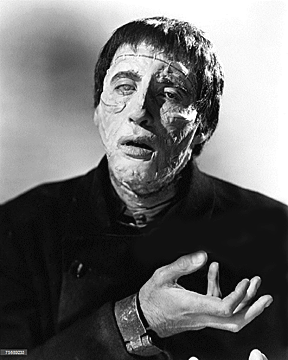 In
1957, the British film studio Hammer released its own version of
Frankenstein called "Curse of Frankenstein," starring Christopher
Lee as the Monster and legendary British actor Peter Cushing as
Doctor Frankenstein. Though the film was vastly different from
Universal's version, it proved to be successful in its own right.
Hammer followed the success of Frankenstein with the 1958 release of
an original adaptation of Dracula, entitled "Horror of Dracula," for
American release. With these new, skillfully crafted offerings
tantalizing audiences, the Universal icons began to lose appeal. In
1957, the British film studio Hammer released its own version of
Frankenstein called "Curse of Frankenstein," starring Christopher
Lee as the Monster and legendary British actor Peter Cushing as
Doctor Frankenstein. Though the film was vastly different from
Universal's version, it proved to be successful in its own right.
Hammer followed the success of Frankenstein with the 1958 release of
an original adaptation of Dracula, entitled "Horror of Dracula," for
American release. With these new, skillfully crafted offerings
tantalizing audiences, the Universal icons began to lose appeal.
“The Creature from the Black Lagoon," Unversal’s last monster, came
along in 1959. Among collectors, he’s the most popular. But as the
1950s waned, so did interest in the monsters. With increased
competition from home and abroad, Universal just couldn’t keep up.
The Birth of Monster Merchandise
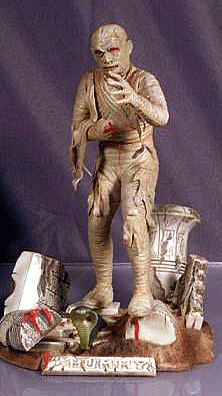 The
Aurora Plastic Corp. was one of the first companies to produce a
line of classic monster merchandise—a model kit of Frankenstein. The
model was so successful that Aurora released 12 more monster kits in
the 1960s including all of the Universal mainstays. After Aurora's
efforts proved successful, numerous other companies climbed aboard
the Monster Express with their own offerings. The
Aurora Plastic Corp. was one of the first companies to produce a
line of classic monster merchandise—a model kit of Frankenstein. The
model was so successful that Aurora released 12 more monster kits in
the 1960s including all of the Universal mainstays. After Aurora's
efforts proved successful, numerous other companies climbed aboard
the Monster Express with their own offerings.
Among the most impressive and collectible are their battery-ops.
Specifically, the battery-operated Frankenstein, which if in
excellent condition, is one of the most sought out of all monster
collectibles:
To meet the demand for monster inspired merchandise, a multitude of
companies began to produce a variety of products.
Though interest in monster collectibles continued its downward
spiral during the 1970s and 1980s, monster collectible sales
continued to be brisk. The 1970s gave way to the action figure,
which dominated the toy scene and monsters became a big part of that
sensation.
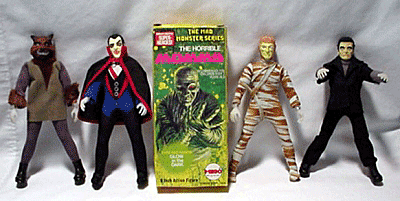 Among
the most collectible monster figures from that time are the 8-inch
AHI figures produced from 1973-1976. Of particular note are those
monsters that sport actual cloth clothing: Mego also introduced its
own line, Mego Mad Monsters, comprised of 8-inch figures available
in individual boxes as well as on cards. In 1974 and 1975, Lincoln
International created a line of 8-inch articulated figures,
particularly noteworthy for their cartoonish look. In the 1980s
Remco manufactured a set of 9-inch figures that have proven very
desirable among collectors. Also popular was their release of 3
3/4-inch Mini Monsters on cards that featured pictures of the
monster as he appeared in the original film. Remco also offered a
Mini Monster carrying case with this line. In 1986 Imperial added
its own 7½-inch rubber figures packaged in bubble packs. Among
the most collectible monster figures from that time are the 8-inch
AHI figures produced from 1973-1976. Of particular note are those
monsters that sport actual cloth clothing: Mego also introduced its
own line, Mego Mad Monsters, comprised of 8-inch figures available
in individual boxes as well as on cards. In 1974 and 1975, Lincoln
International created a line of 8-inch articulated figures,
particularly noteworthy for their cartoonish look. In the 1980s
Remco manufactured a set of 9-inch figures that have proven very
desirable among collectors. Also popular was their release of 3
3/4-inch Mini Monsters on cards that featured pictures of the
monster as he appeared in the original film. Remco also offered a
Mini Monster carrying case with this line. In 1986 Imperial added
its own 7½-inch rubber figures packaged in bubble packs.
 The
latter part of the 1990s witnessed the release of a hord of monster
action figures. In 1993 Telco released a set of Universal Monster
motionettes that included The Wolf Man, Frankenstein, The Bride of
Frankenstein and The Mummy. The Mummy from this set is very
collectible . and will most often sell for more than $100 There was
somewhat of a lull in new classic monster merchandise until 1997. In
that year, the U. S. Post Office released a set of monster stamps as
portrayed by the original Universal actors. The
latter part of the 1990s witnessed the release of a hord of monster
action figures. In 1993 Telco released a set of Universal Monster
motionettes that included The Wolf Man, Frankenstein, The Bride of
Frankenstein and The Mummy. The Mummy from this set is very
collectible . and will most often sell for more than $100 There was
somewhat of a lull in new classic monster merchandise until 1997. In
that year, the U. S. Post Office released a set of monster stamps as
portrayed by the original Universal actors.
Also in that same year, Hasbro manufactured a set of impressive
12-inch figures in individual boxes. The firm based the bodies on
earlier G.I. Joe figures. However, it gave more attention to the
details with these figures and the faces bore a greater resemblance
to the film monster than had been seen in some time. To add to the
resurgence in monster popularity was a set of plastic 4-inch toys
figures sold only as a promotional item at Burger King. Once again,
toy departments displayed monster toys.
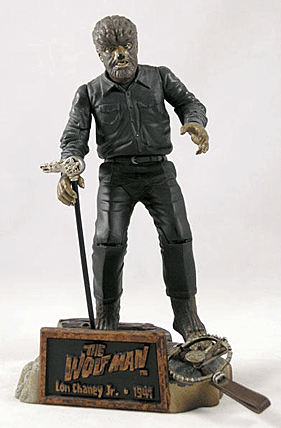 Of
all the action figures produced, the ones released by Sideshow Toys
in the late 1990s were the most realistic. Licensed by Universal and
in agreement with the estates of Boris Karloff and Lon Chaney Jr.,
the 8-inch figures in the first series consisted of Frankenstein;
The Mummy, and the Wolf Man. The success of the first series and the
demand generated by collectors has spawned new Sideshow offerings.
Series 4 figures include Son of Frankenstein The Mole Man and The
Werewolf of London. The only figure missing was of Dracula, which
Sideshow was finally able to produce after reaching an agreement
with the estate of Bela Lugosi. Of
all the action figures produced, the ones released by Sideshow Toys
in the late 1990s were the most realistic. Licensed by Universal and
in agreement with the estates of Boris Karloff and Lon Chaney Jr.,
the 8-inch figures in the first series consisted of Frankenstein;
The Mummy, and the Wolf Man. The success of the first series and the
demand generated by collectors has spawned new Sideshow offerings.
Series 4 figures include Son of Frankenstein The Mole Man and The
Werewolf of London. The only figure missing was of Dracula, which
Sideshow was finally able to produce after reaching an agreement
with the estate of Bela Lugosi.
Not surprisingly an early 1960s survey of young people by the Aurora
Plastics Company showed the interest in monster mania generated by
old films, which had begun to be shown on TV. Aurora took a big
chance in releasing its monster models. It began by only releasing
its Frankenstein kit to test the public’s acceptance.
By late 1961 Aurora's boxed Frankenstein assembly kits were in
stores and instantly sold out. A second mold was quickly made to
keep up with the demand, according to Breugman, and soon the plant
was in production 24 hours a day.
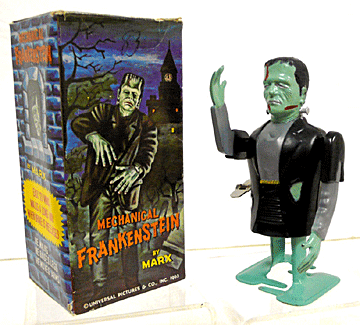 World
famous toy maker Marx noticed the excitement and added their own
Frankenstein toys in 1963, including a plastic monster figure.
Another Marx offering was a large remote control model of the
monster, and still another was a wind-up Mechanical Frankstein with
plastic head and metal legs. World
famous toy maker Marx noticed the excitement and added their own
Frankenstein toys in 1963, including a plastic monster figure.
Another Marx offering was a large remote control model of the
monster, and still another was a wind-up Mechanical Frankstein with
plastic head and metal legs.
Other related toys from that era included the Frankenstein wind-up
with a plastic monster figure in a four-and-a-half-inch-tall antique
car, and a boxed battery operated litho tin Frankenstein Monster.
Both came from Japan.
During the 1970s, Aurora continued their early kit success by
including Frankenstein in their Monsters of the Movies series.
However, there was more interest in already constructed five to
eight inch plastic monster figures, and soon other makers flooded
the market. Mego sold a Mad Monster series starting in 1974 which
included Dreadful Dracula, Human Wolfman, Horrible Mummy, the Mad
Monster Castle, and Monster Frankenstein. Others with similar
figures on the market included Ace Novelty, Lincoln International,
Kenner, Remco Industries and eventually Imperial.
One of the last of the battery-operated Frankenstein figures came in
the 1970s from Poynter Products. The 12-inch monster was almost
entirely made of plastic.
The World of Resin
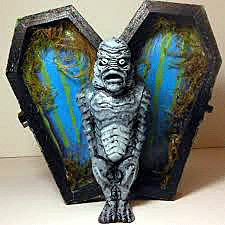 While
toy companies continue to make monster collectibles, a new
generation of artists has begun creating monsters of their own—but
this time in resin. All the major monsters have begun appearing out
of the sticky ooze. While
toy companies continue to make monster collectibles, a new
generation of artists has begun creating monsters of their own—but
this time in resin. All the major monsters have begun appearing out
of the sticky ooze.
Four of these artists have taken monster collectibles to new
heights.
Daniel Madden of Maddens Monsters sculpts and paints figures
creatively exaggerated to make them even scarier. He also sells the
blanks so people can paint their own. He’s particularly fond of
creatively interpreting Dracula, complete with mini-coffin. He
offers a Creeper series f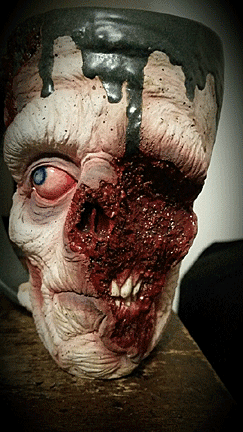 eaturing
all the classic monsters, including Frankenstein, Dracula, Wolfman,
the Mummy, and the Creature from the Black Lagoon, all of which sell
for $45 to $48 each. eaturing
all the classic monsters, including Frankenstein, Dracula, Wolfman,
the Mummy, and the Creature from the Black Lagoon, all of which sell
for $45 to $48 each.
Scott Wilkowski sculpts his monsters out of resin but gives
them an inside-out transparent look. While Madden plays around with
the classics, Wilkowski follows his own path with his “Infected
Dunnies,” what look to be X-ray rabbits. These little darlings can
be pricey, selling for $175 each.
Chad
Scheres, another monster sculptor and painter, specializes
in ghoulish zombies that often appear as if melting away. A master
resin sculptor, Scheres thinks outside the box for his creations. A
custom zombie, handmade monster mask featuring a full head of
ghoulishness, sells for $75 in Scheres’ eBay store.
To read
more of my articles, please
visit
my Web site.
< Back
to Collectibles Archives
Next Article >
|
